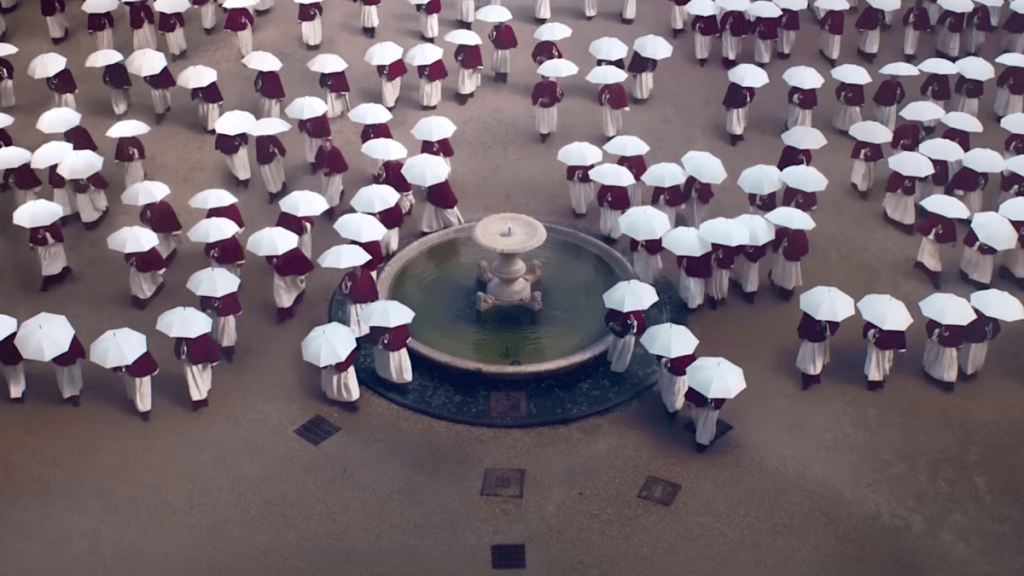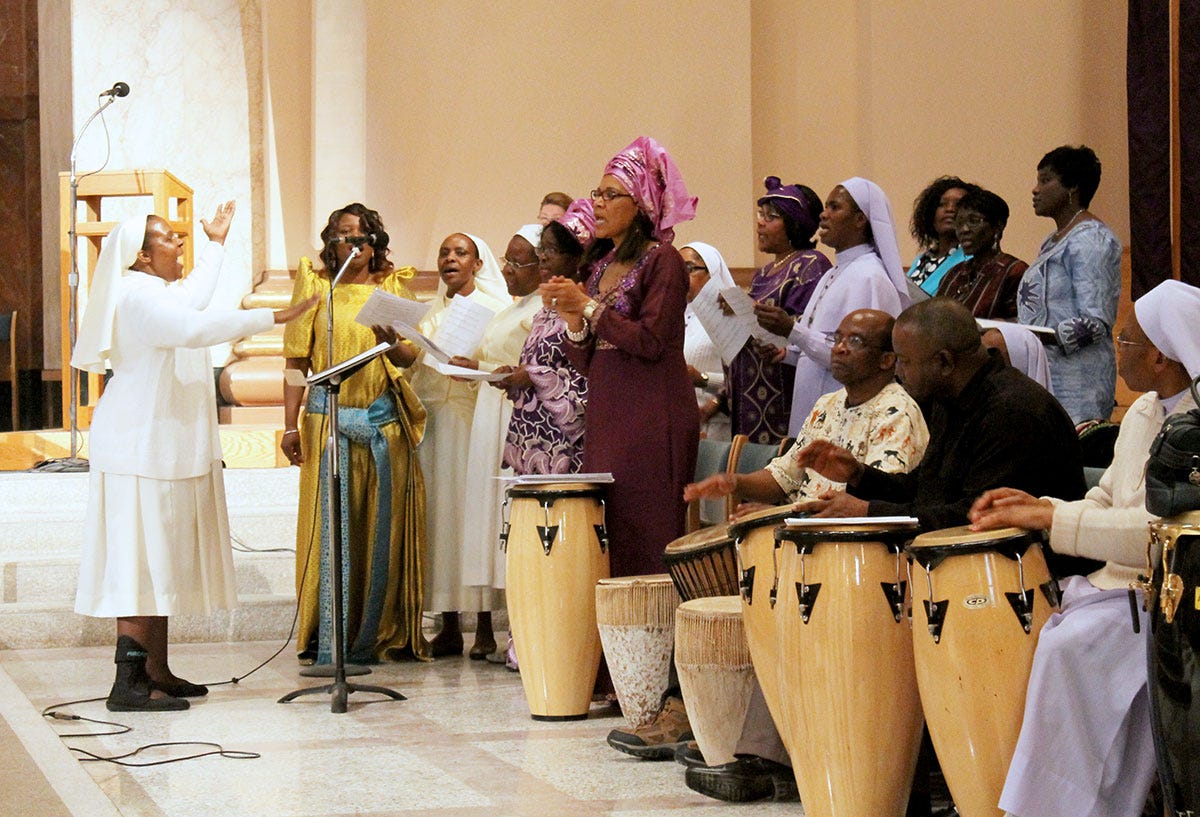Spoiler warning: The following mentions significant plot twists from “Conclave”
You may not be interested in Catholicism, but Catholicism is interested in you. Seven out of eight cogent US Supreme Court Justices are Catholic.1 The Catholic Church has resettled one third of the refugees that the U.S. has received from 1987 to 2016; over one million. Yesterday, world dignitaries attended the funeral of Pope Francis in Rome. Today, 1.4 billion believers wait for the smoke that signals, Habemus Papam.
When Robert Harris released Conclave, he gave outsiders four archetypes of modern Catholic power: the Euro traditionalist, the Euro progressive, the Based Black Guy, and the Filipino Peacemaker. Though Catholic intellectuals resist analogies to secular politics, Harris’s broad buckets serve as a useful guide to the real factions now gathering in Rome, and provide an entry point into exploring the Church’s history.2
In 380 CE, Theodosius I declared Christianity the official religion of the Roman Empire. The Christian Church aggressively promoted monogamy, which forced elite men to have children with elite women, creating selection pressures for intelligence. This eugenic pressure intensified in the 14th century’s Western European Marriage Pattern, which required men to achieve economic independence before marriage.
The Age of Exploration spread Christianity worldwide, and according to the Pontifical Yearbook 2025, Europe now houses just 20% of Catholics—and declining fast. Half of all believers live in the Americas, where numbers remain relatively stable. 10% of the faithful live in Asia, which has seen moderate growth, but the Vatican celebrates Africa, home to 20% of Catholics, as the most “dynamic” growth region.
Zairean rites and Chinese wrongs
Pope Francis was Latino, and a frontrunner for papal succession both in Conclave and in real life is Filipino. But there is no market for the idea of a “First Asian Pope.” On the other hand, tastemakers frequently speculate about the “First Black Pope.”3 This asymmetry follows the secular fashion of Afropessimism, which posits the idea of a “global antiblackness” that transcends time, space, and local power relationships.4
There is precedent for a papacy that wraps secular ideology in religious language. “Liberation theology” emerged out of Latin America in the 1960s, mobilizing churchgoers against enemies defined by Marxist analysis: often the rich specifically, and “oppressors” generally. Its highest-profile adherent, Pope Francis, lived these principles, even apologizing for the Church’s role in the colonization of the Americas.
The Roman guilt of today contrasts with Church attitudes in the 17th-18th centuries. When Catholic missionaries in China and South India encountered pre-existing customs like bowing before ancestral tablets or Sanskrit chants, they debated whether to incorporate or forbid them. The “Chinese Rites controversy” and “Malabar Rites controversy” respectively ended in a total ban on Asian “superstitious” practices.5
Serious Catholic evangelizing in Africa’s interior had to wait until the 20th century, when comprehensive malaria-control protocols drastically reduced missionary deaths. In 1963, Vatican II committed the Church to “respecting and fostering the qualities and talents of the various races,” and by 1988 Rome approved the “Zairean Rites,” allowing for drumming and dancing, call-and-response, and African names for God.6
Playing defense in a Church offsides
The Catholic concept of synodality promotes decentralized decision-making, but European progressives found that some local churches are more equal than others. When Germany’s synod requested gender reforms in 2023, Rome responded with threats.7 But in 2024, after allowing for limited blessings of same-sex unions, Francis said that “A special case are Africans,” and that their cultural dissent is permissible.
If this special treatment continues, we can guess which changes to Catholic teachings come next. Africa hosts several breakaway “Reformed Catholic Church” movements where excommunicated clerics reject central teachings on sexuality in favor of local practices like married priesthood or polygamy. Others formally toe the line while maintaining secret families; this spoils the Based Black Guy’s candidacy in Conclave.

The 2013 conclave that elected Francis was perfect timing for a Third World liberation theologist. The Vatileaks scandal of 2012 weakened the Italian voting bloc and fueled resentment from Global South cardinals against Vatican insiders. There was also hope that Francis’s “pastoral,” direct-to-the-people approach would revitalize Church attendance in Europe, though this “Francis Effect” never materialized.
Instead, the Vatican’s budget priorities over the past decade tell a story of a Public Relations-focused papacy. The Dicastery for Communication received nearly as much funding as the department for diplomacy, and 19 times as much funding as for the office for suppressing false doctrines. Media stunts dominated the Pope’s schedule; with, for example, his washing prisoners’ feet in a ritual designed to honor priests.
The long war on centuries of idolatries
The narrative that elevated Francis to pontiff was simple: kissing the feet of South Sudanese warlords and Muslim asylum seekers would lure lapsed liberals back into the pews. Birth-cohort data show the opposite. Liberals exited, and the remainers are smaller and markedly more conservative.8 This selection effect is sharper among the clergy, with each newer ordination class identifying as more right-wing than the last.

What do these traditionalists want? As a stump speech from the novel puts it, “We do not need a church that will move with the world but a Church that will move the world.” For centuries, this Roman institution demanded sacrifices from its followers. In Europe, the Church smashed the idols of pagan, transactional gods. In Asia, the Church fought clannishness and particularism. Then, the universal church stopped.9
The final dramatic act of Conclave comes in the form of an Islamic terrorist attack. Our Smiling Filipino Moderate’s post was conveniently in Baghdad, so he knows a thing or two about playing nice with Muslims! The scared cardinals abandon their ideological priors and switch their votes to the dark horse candidate. The new pontiff is “sitting on a secret”: despite living his whole life as a man, he has female genitalia.10
In this culture war-brained screenplay adaptation, the twin idolatries of our age, “Black Lives Matter” and “Trans People are Sacred,” overshadow anything God says. But if the church borrows its moral worldview from the slogans outside, then what does Sunday worship offer besides what secular schools and media already supply? For universal moral progress to continue, these new idols must be smashed too.
Gorsuch was confirmed Catholic, but attends Episcopal services, and the two denominations remain extremely compatible. Kagan, a Jew, is praised across the political spectrum for her writing and reasoning, which is accessible, rigorous, and entertaining. KBJ deserves her own article, but she has a reputation for confusing historical narrative with textual interpretation, and for uncritically citing fraudulent and tendentious social science.
Approximate mappings from archetype to Conclave to real life are as follows:
Based Black Guy → Adeyemi → Peter Turkson or Robert Sarah or Ambongo
Euro traditionalist → Tedesco → Péter Erdő or Raymond Burke
Euro progressive → Bellini → Matteo Zuppi or Jean-Marc Aveline or de Mendonça
Smiling (Filipino) Moderate → Benítez → Luis Antonio Tagle or Pizzaballa
To avoid hairsplitting, I am skipping the Tremblay and Lomeli/Lawrence characters.
The book mentions that Adeyemi “carried within him like a divine spark the revolutionary possibility, endlessly fascinating to the media, that he might one day become ‘the first black Pope.’” The narrator repeatedly expresses excitement about the possibility in his own voice. Already, for the 2025 conclave, we see the spread of the “first Black pope” meme across:
Reuters (April 22), a secular wire service.
The Sunday Times (April 22), a British newspaper.
Black Catholic Messenger (April 23), a religious (!) news outlet.
The New Yorker reviewed Frank Wilderson’s book, “Afropessimism,” which is mostly memoir. The professor of African-American studies at UC Irvine founded this philosophical school based on ideas which emphasize how non-black “people of color” are “junior partners” to whites in the enslavement of blacks. It includes many quotes whose language are echoed in 21st century left-wing activism:
“the spectacle of Black death is essential to the mental health of the world.”
“Blackness is coterminous with slaveness”
“Dr. Zhou [a nameswapped Chinese-American doctor in Wilderson’s memoir] is as much a master as Edwin and Mary Epps, the antagonists in 12 Years a Slave.”
“in the collective unconscious, Palestinian insurgents have more in common with the Israeli state and civil society than they do with Black people.”
The only way to cure the condition of slavery that ails black people is “the end of the world.”
In an interview reflecting on Afropessimism’s influence in 2020, Wilderson places his thought in a broader tradition that makes a claim of black exceptionalism: “what Frantz Fanon has shown, is that everyone’s unconscious aspires toward the light, toward whiteness. It’s just that what we mean by whiteness/Humanness can contract and expand over time but it can never incorporate Blackness.”
Pope Clement XI’s 1704 decree, Cum Deus optimus, not only condemned the Chinese rites but also outlawed any further discussion on the matter. His subsequent Papal Bull in 1715 outlined further details of the prohibitions; for example, “Chinese Catholics are not allowed to perform the ritual of ancestor worship, even at funerals or in the cemetery. They are not allowed to do so even if in the company of non-Christians, for this ritual is deemed as a Chinese pagan practice regardless of circumstance.” It also labeled local Christian words for God, Tiān and Shàngdì, as blasphemous, permitting only the missionary-coined Tiānzhǔ.
Zaire is the old name for the country now known as the Democratic Republic of the Congo. The Vatican II quote comes from Sacrosanctum Concilium §37. “African names” refers to words in local languages, not invented by missionaries, that were used for non-Christian deities. So a Lingala speaker can pray to Nzámbe, or a Swahili speaker can pray to Mungu, and the Church would accept this as Christian, in contrast to the Mandarin Shàngdì. This is why, to this day, Chinese Protestants use a different word for God than Chinese Catholics! Francis has teased a future “Amazonian Rite,” but as of today, only Africa won special rites.
Specifically, Germany’s Synodal Way approved motions to request a review of celibacy rules, and to change baptismal records to match self-identified gender. The Vatican threatened disciplinary action against the European bishops for defying doctrine.
From the Pew Research Center’s “Decline of Christianity in the U.S. Has Slowed, May Have Leveled Off: Findings from the 2023-24 Religious Landscape Study” (summary, pdf): 62% of U.S. adults in 2023-2024 identify as Christian, and 19% identify as Catholic specifically. The decline has stabilized since 2007, when 78% identified as Christian and 24% as Catholic. Among U.S. adults who were raised Catholic, the amount that remain Catholic by birth decade is shrinking, from 71% in the pre-1950s cohort to 52% from the 2000-2006 born (p.148). Of those who stayed, 36% now identify as conservative and 18% as liberal, with a 49 %-44 % favor the GOP (p.233), which shows that the shift is from selection, not conversion.
See Max Weber’s “disenchantment of the world” concept for more on why the stamping out of magical beliefs is important for modernity. Jews and Christians used to agree on this:
Deuteronomy 18:10-11: “Let no one be found among you who sacrifices their son or daughter in the fire, who practices divination or sorcery, interprets omens, engages in witchcraft, or casts spells, or who is a medium or spiritist or who consults the dead.”
But disagreement arises when such practices are not Roman, Indian or Chinese but African.
The details differ between the book and the movie. In the novel, Benítez’s secret surgery is to “correct a fusion of the labia majora and minora, and a clitoropexy,” while in the movie, it is a hysterectomy. In any case, the film-to-screenplay raceswap from Filipino to Mexican undermines the “intersex” gag, because a major breadcrumb in the Benítez transvestigation is that the cardinal did not need to shave his face during his time in the conclave.



